All three suites have distinct advantages as well as distinct advantages. I make it clear now that not one of these suites is perfect. Whether it be lack of features, ease of installation or even pricing, all of these suites have there faults.
Microsoft Office XP
![]() Microsoft Office XP is the latest version of the most popular office suite on the face of this earth. It is also the industry standard at this current point in time! Ever since the Windows 3.1 days has Microsoft had a monopoly on the Office suite market and with this release, the trend is likely to continue. This version adds the new Windows XP look and does more to get you working more efficiently once it is set up for your own personal needs. Office XP is a suite of seven applications integrated into an office suite.
Microsoft Office XP is the latest version of the most popular office suite on the face of this earth. It is also the industry standard at this current point in time! Ever since the Windows 3.1 days has Microsoft had a monopoly on the Office suite market and with this release, the trend is likely to continue. This version adds the new Windows XP look and does more to get you working more efficiently once it is set up for your own personal needs. Office XP is a suite of seven applications integrated into an office suite.
| Microsoft Word 2002 - Word Processor | |
| Microsoft Excel 2002 - Spreadsheet | |
| Microsoft PowerPoint 2002 - Presentation Designer | |
| Microsoft Outlook 2002 - Personal Information Manager | |
| Microsoft Access 2002 - Database | |
| Microsoft Publisher 2002 - Desktop Publisher | |
| Microsoft FrontPage 2002 - HTML Editor |
The Office XP suite is split up into four categories at the moment. You have the Standard, Professional, Developer, and the Small Business Edition. All four of these versions can be purchased OEM but only three can be bought through retail at this present moment in time in Australia. The Small Business Edition will eventually be available through retail channels but in Australia at the moment, it is strictly OEM. Bellow shows you the included programs in each suite.
| Microsoft Office XP Standard (AU$969) | |
| Microsoft Office XP Small Business Edition (AU$NA) | |
| Microsoft Office XP Professional (AU$1159) | |
| Microsoft Office XP Professional - Limited Upgrade Edition (AU$879) | |
| Microsoft Office XP Developer (AU$1539) |
There will be some variation in price. These prices were from a local distributor from September 2001. As you can see Microsoft puts a hefty price tag for an industry standard. For this review, I've used Office XP Professional with the addition of Microsoft Publisher. Because I'm a student, I got this bundle for less than AU$600. I don't have FrontPage 2002 but I've seen it working and it is similar to FrontPage 2000. This is why the screen shots below don't include FrontPage 2002.
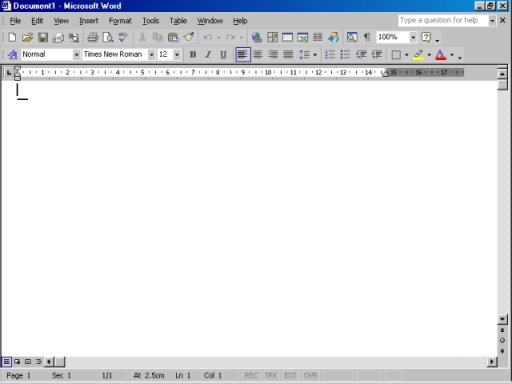
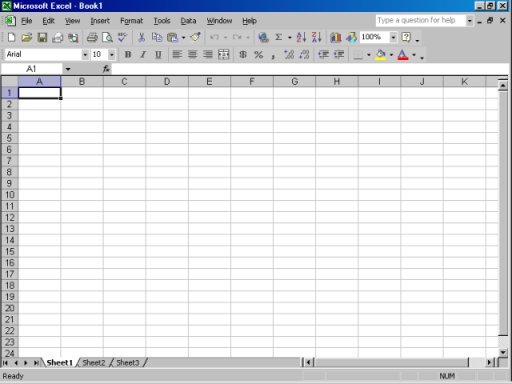
Micrsoft Excel 2002
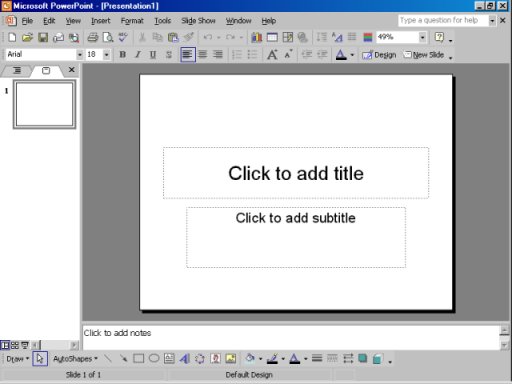
Microsoft PowerPoint 2002

Micrsoft Outlook 2002
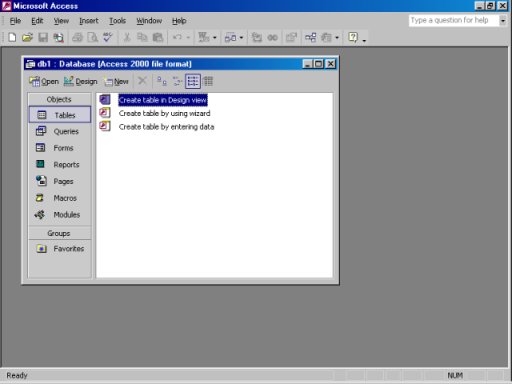
Microsoft Access 2002

Microsoft Publisher 2002
A full install of Microsoft Office XP Professional and Microsoft Publisher 2002 on a clean install of Windows 98 Second Edition. All problems if any were documented for this suite. Here are the Microsoft Office XP system requirements.
| Required Configuration | |
| CPU: | Intel Pentium 133MHz Intel Pentium II 400MHz for voice regonition |
| RAM: | 32MB (Windows 98) 40MB (Window Me & Windows NT 4.0 64MB (Windows 2000 & Windows XP) 128MB (Voice Recognition) |
| Video: | 2MB PCI SVGA 800x600 |
| Sound: | Not required PCI Sound (Voice Recognition) |
| Operating System: | Microsoft Windows 98 or higher Windows NT 4.0 SP6 or higher Windows XP |
| Other: | 245MB (minimum install) CD-ROM |
| Recommended Configuration | |
| CPU: | Intel Pentium III 533MHz |
| RAM: | 128MB 256MB (Windows XP) |
| Video: | 4MB Direct Draw AGP compatible |
| Sound: | Direct Sound PCI compatible |
| Operating System: | Windows 2000 Windows XP |
| Other: | 850MB (full install) CD-ROM 14.4k modem |
KDE KOffice
![]() KOffice is a newcomer to the office suite arena and it is only available on UNIX based systems like Linux with KDE 2.x.x installed. This suite is destined to be one of the most popular suites on Linux because whether you are running an up to date distribution like Mandrake Linux 8.0 or Red Hat Linux 7.1 or you have an older distribution with KDE upgraded to version 2.x.x, you have KOffice already on your PC. This suite integrates perfectly with the K Desktop Environment to provide a fast and extremely useable office suite. KOffice is made up of four primary applications along with two secondary ones as well.
KOffice is a newcomer to the office suite arena and it is only available on UNIX based systems like Linux with KDE 2.x.x installed. This suite is destined to be one of the most popular suites on Linux because whether you are running an up to date distribution like Mandrake Linux 8.0 or Red Hat Linux 7.1 or you have an older distribution with KDE upgraded to version 2.x.x, you have KOffice already on your PC. This suite integrates perfectly with the K Desktop Environment to provide a fast and extremely useable office suite. KOffice is made up of four primary applications along with two secondary ones as well.
| KWord - Word Processor | |
| KSpread - Spreadsheet | |
| KIllustrator - Graphics Manipulation | |
| KPresenter - Presentation Designer |
The two other applications are KChart, which is basically a charting program for KSpread and KMail, which is KDE's default email client. Technically KMail isn't a part of KOffice because it has been a part of KDE since the original KDE 1.x releases but it is beginning to be associated with KOffice. Here are some screen shots of KOffice applications.

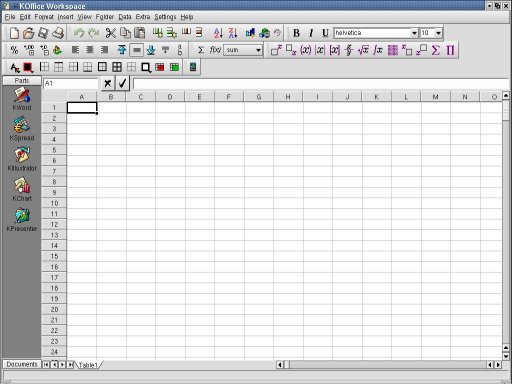
KSpread

KIllustrator

KChart

KPresenter
KOffice was installed with a clean installation of Red Hat Linux 7.1 with KDE 2.1.1 set as the default X11 manager. System requirements for KOffice vary depending on what distribution of Linux you are running and what services you have on your machine. The requirements below are just a base guide and they will vary.
| Required Configuration | |
| CPU: | Intel Pentium II 300MHz |
| RAM: | 64MB |
| Video: | 2MB PCI X11 compatible |
| Sound: | Not required |
| Operating System: | Linux 2.2.x |
| Other: | KDE 2.x.x |
Sun StarOffice 5.2
![]() Sun have positioned their StarOffice 5.2 suite as a fully integrated desktop suite that runs on both Windows and Linux. StarOffice is more than just an office suite, it is also a fully featured Internet browser as well. StarOffice 6 BETA is out for testing and the integrated desktop is gone but I chose not to use this version because it isn't a full production suite. StarOffice 5.2 is almost fully compatible with Microsoft Office in both it's Windows and Linux versions. It is one of the few great fully featured Office suites for Windows that are free for download or for purchase on CD for a nominal charge. StarOffice is a suite of eight applications with most being similar and compatible with Microsoft Office.
Sun have positioned their StarOffice 5.2 suite as a fully integrated desktop suite that runs on both Windows and Linux. StarOffice is more than just an office suite, it is also a fully featured Internet browser as well. StarOffice 6 BETA is out for testing and the integrated desktop is gone but I chose not to use this version because it isn't a full production suite. StarOffice 5.2 is almost fully compatible with Microsoft Office in both it's Windows and Linux versions. It is one of the few great fully featured Office suites for Windows that are free for download or for purchase on CD for a nominal charge. StarOffice is a suite of eight applications with most being similar and compatible with Microsoft Office.
| StarOffice Writer - Word Processor | |
| StarOffice Calc - Spreadsheet | |
| StarOffice Impress - Presentation Designer | |
| StarOffice Draw - Graphics Manipulation | |
| StarOffice Base - Database | |
| StarOffice Schedule - Personal Information Manager | |
| StarOffice Mail - Email Client | |
| StarOffice Discussion - News Reader |
As you can see StarOffice has a vast range of applications. One thing that could be done is to merge StarOffice Mail, Discussion and Schedule into just one application and maybe include a desktop publishing application. Here are some pictures of the Linux version of StarOffice 5.2. There is no feature difference between the Windows and Linux versions. I used the Linux version because my Windows copy is only 5.1 and is slightly older.
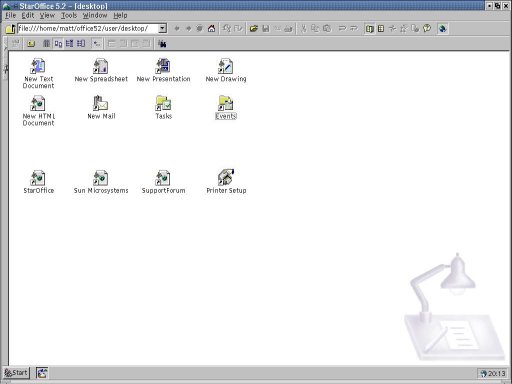
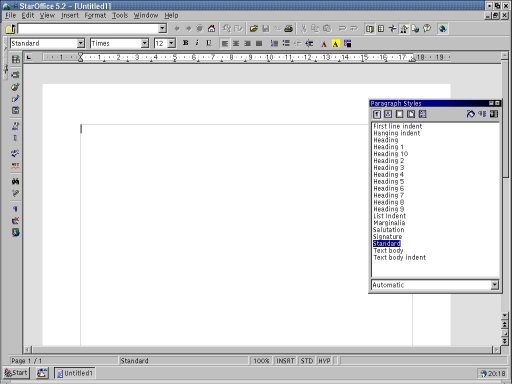
StarOffice Writer
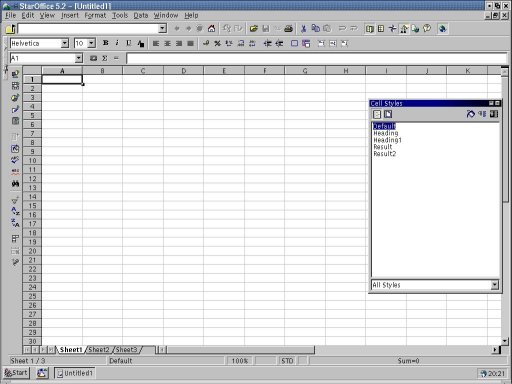
StarOffice Calc

StarOffice Impress

StarOffice Draw
A full install of StarOffice 5.2 was installed on my system after a clean install of Red Hat Linux 7.1 with KDE 2.1.1 set as the default X11 windows manager. A full install of StarOffice 5.1 was installed on my system under Windows 98 to test compatibility between both the Windows and Linux versions.
I was unable to get accurate minimum requirements at this time but I personally wouldn't run it on a system of less than 300MHz or less than 64MB RAM. A minimum install requires 200MB while a full install requires 268MB.
The Comparison
Now that all the information on the actual office suites is out the way it's time to get on with the actual comparison. Even though there is no benchmarking done in this review, I've included my system setup for people who want to know exactly how I ran the software.
| System Configuration | |
| CPU: | Intel Pentium III EB 733MHz |
| RAM: | 256MB PC133 CAS3 SDRAM |
| Motherboard: | MSI MS-6309 (VIA Apollo Pro 133A) |
| Video: | 32MB AOpen PA3020 Pro AGP (nVidia RIVA TNT2 Pro) |
| Sound: | Creative Sound Blaster VIBRA128 PCI |
| Operating System: | Microsoft Windows 98 Second Edition Red Hat Linux 7.1 |
| Software: | Microsoft Office XP Professional Microsoft Publisher 2002 StarOffice 5.1 (Windows) StarOffice 5.2 (Linux) KOffce |
| Windows 98 Only | |
| Chipset Driver: | VIA 4in1 4.32 |
| Video Driver: | nVidia Detonator 12.41 |
| Other Drivers: | Direct X 8.0a |
| Red Hat Linux 7.1 Only | |
| Kernel Version: | 2.4.2 Stable |
| X Version: | XFree86 4.03 |
| X GUI: | KDE 2.1.1 |
| X Video Driver: | nVidia Linux Detonator 1.0-1251 |
Instead of giving just an overall result I've broken them down into categories. This is to show you the strengths and weaknesses of each suite. The categories are price, ease of install, ease of use, features, cross-platform usability, and availability. Of coarse after looking at the results from each category, I will give an overall score.
Price
The pricing of these three suites goes from one end of the scale to the other. KOffice is totally free because it is distributed with the K Desktop Environment and sometimes with the Linux operating system that includes KDE 2.1.1. StarOffice 5.2 is also free for download if you can download the 60MB+ download or you can purchase it on CD for a nominal charge. Microsoft Office XP is at the other end of the scale. For the full professional version like I have, you'd have to part with over AU$1000 for the full retail version. This might seem steep but Microsoft have made some concessions that allow students purchase this product at a substantially reduced rate but this still doesn't excuse the extremely high pricing. I think the main reason for the high pricing is Microsoft Office is perceived as the industry standard. It's not a coincidence Adobe Photoshop is so expensive! Overall KOffice is the best price wise because it is totally free!
Winner: KOffice
Ease of Installation
The installation of KOffice is two faced. If you have a distribution with KDE 2.x.x installed with the Linux operating system then KOffice is automatically installed for you. If on the other hand you don't have a distribution with KDE 2.x.x, you will have to install it and after attempting this, I'd say it's definitely not for the novice. StarOffice for both Window and Linux have the same installer GUI. It installs just like nearly every other Windows application and you should have no trouble as long as you follow the steps. Microsoft's installation program has to update vital system files and it handles these very well buy automating the whole installation. You just have to click a few buttons and you're away. If you need to customize the installation to your exact requirements you can do this also with minimum fuss. The Office XP installation program is the pick of the bunch!
Winner: Office XP
Ease of Use
KOffice was pretty easy to use without having any prior knowledge of the software. I was able to locate nearly all the features first up and the features I didn't find, I had worked out within ten to fifteen minutes. StarOffice took me the longest to work out because the interface was somewhat clumsy. After I worked out where things were organised, I began to get used to the program and it was smooth sailing from then on. Microsoft Office XP is a very complex beast. If you are a new user, you will be totally at a loss. Many of the advanced programs like Access are difficult to use for the first time. Microsoft realise this and ship an interactive training CD which goes through basic tasks in Office XP for all the programs. KOffice is still the easiest to use out of the bunch.
Winner: KOffice
Features
KOffice is just your regulation basic office suite without any of the fancy trimming contained in other office suites. It gets the job done and does it well but don't expect anything special. StarOffice is brimming with features. The first of which you come face to face with when you start it up. StarOffice integrates the desktop and Start Menu into the application itself to make it appear like it has taken over the whole computer. Some people think it's a good feature but many dislike it. This feature allows you to nearly run your whole computer while not leaving the StarOffice environment. Of coarse if you are one of those people who don't like this feature, you can disable it. As with the desktop integration, all the applications run from within the StarOffice environment meaning there is less clutter on the Taskbar. The last feature to note is the integrated web browser. StarOffice is almost an all in one solution. Microsoft have slowly beginning to run out of new features to put into their office suites. With the introduction of Office XP you now have integrated voice recognition. It is sort of usable but I wouldn't use trust it instead of the keyboard because it has quite a bit of trouble interpreting word and quite often puts the wrong text on the screen. One thing it is usable for is when it's in the "Voice Command" mode. This allows you to navigate the menu as easy as saying, "File, Open, OK." This feature is really innovative even if it doesn't work as expected. The next feature is Microsoft's new anti-piracy tool. It has been upgraded similar to the one used in Windows XP. Many people wouldn't call this a feature but after testing it on two computers, (Installing it on my old computer and activating it, then removing it, then installing it on this computer I'm using to write this review and activating it.) and the result was no trouble at all. It activated first time and every time. If you are a legit user then you will have nothing to worry about but if your a pirate, then you have a thorn in your side. Office XP like the soon to be release Windows XP is also task orientated. Everything I can do in Office 2000, I can now do substantially faster. Feature wise overall, it's a tie between Office XP and StarOffice!
Winner: Tie - Office XP/StarOffice
Cross Platform Support
To put it simple, KOffice features no support for other file names at all on both the import and export side of things. If you use KOffice, you have to continue to use it along with a Linux PC. StarOffice has support for UNIX files as well as most of the popular Windows file extensions for Office 97 and some Office 2000 file types as well as all the others like WordPerfect and older applications. StarOffice allows you to both import and export files of these types as well as the native StarOffice file names. StarOffice is also the only suite that runs under Linux and Windows with full compatibility between the two versions for file support. You can't install your Windows StarOffice CD on a Linux PC though. Microsoft Office XP has good cross platform support but this is mainly due to them being the industry standard where other suites include support for Microsoft file formats to help them be compatible with Office. The only other file formats Office XP allows you to use is previous versions of Microsoft applications like Word, Works, Excel and Access, as well as some Corel and Lotus file formats as well. There is no support on the Linux side of things for file formats though. StarOffice is the clear winner here!
Winner: StarOffice
Availability
KOffice is available for download with KDE 2.x.x or is included on nearly if not all new Linux distributions. The only problem is that if you use KOffice, you will lock yourself into Linux only, if you are not willing to lose your old KOffice documents. StarOffice is available free for download but it isn't vaible on a 56K modem due to it being 60MB+ in size. You can also buy StarOffice on CD for a nominal charge. With StarOffice you are not operating system limited. You can move between Windows and Linux quite easily. Microsoft Office can be found at any good software retailer and it is even loaded onto machines by OEM dealers like Compucon, Dell and Gateway. If you chose Office, you aren't limited to just Windows because of the industry standard factor. Many Linux applications like StarOffice for Linux and other small programs like AbiWord can import and save Microsoft file formats but not with 100% accuracy. Overall it is a tie between Micrsoft Office and StarOffice. You can only download KOffice right now and your locked to Linux. StarOffice would have edged out Office XP if it wasn't for the fact that regardless of price, it can be bought in most software outlets all over the globe!
Winner: Tie - Office XP/StarOffice
Overall
After looking over the above, I'd have to say Microsoft Office XP and StarOffice are pretty much equal. One thing does sway me to the Office XP side is the industry standard issue. If you want full compatibility, it's Microsoft Office or pretty much nothing. If on the other hand file compatibility is not what you need, both Microsoft Office XP or StarOffice will serve you well so it's a tie on paper. My own view it's.........
Microsoft Office XP - By a Wisker